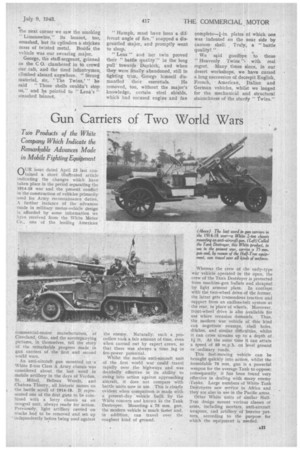Gun Carriers of Two World Wars
Page 23

If you've noticed an error in this article please click here to report it so we can fix it.
Two Products of the White Company Which Indicate the Remarkable Advances Made in Mobile Fighting Equipment
Oli13. issue dated April 23 last contained a short illuStrated article indicating the changes which have taken place in the period separating the 1914-18 war and the present conflict in the construction of vehicles primarily used for Army reconnaissance duties. A. further instance of the advances made in military motor-vehicle design is afforded by some information we have received from the White Motor Co., one of the leading American
commercial-motor manufacturers, of Cleveland, Ohio, and the accompanying pictures, in themselves, tell the story of the remarkable progress made in gun carriers of the first and second world wars.
An anti-aircraft gun mounted on a White 2-ton Class A Army chassis was considered about the last word in mobile artillery in the days of Verdun, St. Mihiel, Belleau Woods, and Chateau Thierry, all historic names on the battle scroll of 1914-18. It represented one of the first guns to be combined with a lorry chassis as an integral unit, always ready for action. Previously, light artillery carried on trucks had to be removed and set up independently before being used against
the enemy. Naturally, such a procedure took a fair amount of time, even when carried out by expert crews, so that there was always a time lag in fire-power potential.
Whilst the mobile anti-aircraft unit of the . first world war could travel rapidly over the highways and was decidedly effective in its ability to swing into action against approaching aircraft, it does not compare with battle units now in use. This is clearly evident when comparison is made with a present-day vehicle built by the White concern and known as the Tank Destroyer. Mounting. a 75 mm. gun, the modem vehicle is much faster and, in addition, can travel over the roughest kind of ground. Whereas the crew of the early-type war vehicle operated in the open, the crew of the Tank Destfoyer is protected from machine-gun bullets and shrapnel by light armour plate. In contrast with the two-wheel drive of the former, the latter gets tremendous traction and support from an endless-belt system at the rear, in place of wheels. Moreover, front-wheel drive is also available for use where occasion demands. Thus, the modem war vehicle of this kind can negotiate swamps, shell holes, ditches, and similar difficulties, whilst it can cross streams up to a depth of.. 11 ft. At the same time it can attain a speed of 50 m.p.h. on level ground or ordinary roads.
This fast-moving vehicle can be brought quickly into action, whilst the formidable 75 mm. gun is a powerful weapon for the average Tank to oppose: consequently, it has been found very effective in dealing with many enemy • Tanks. Large numbers of White Tank De4royers saw serVice in Africa and they are also in use in the Pacific areas. Other White units of similar HalfTrac design mount various classes of arms, including mortars, anti-aircraft weapons, and artillery of heavier pattern, according to the purpose for which the equipment is needed.




















































